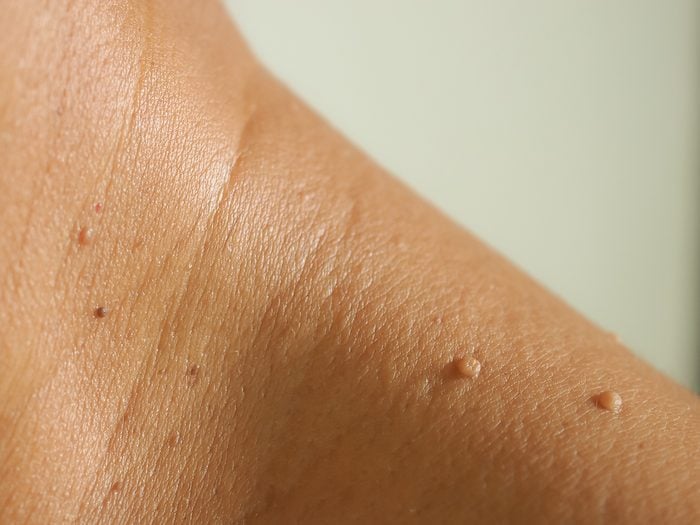Here’s Why You Got a Skin Tag and What to Do If You Want It Gone

A dermatologist shares if skin tags can be prevented, and how their removal works.
For many people, skin tags are simply a fact of life, especially as we age. But in the pursuit of an even skin tone, skin tags can be bothersome aesthetically. Beyond that, they can also become physically irritated, which are two reasons many people consider skin tag removal.
Unlike other growths that can crop up on the skin, such as warts, skin tags are small and benign. Also called acrochordons or fibroepithelial polyps, skin tags are non-cancerous and generally appear as lesions that are the same colour as your skin (or a little darker) and are connected to the skin’s surface by a stalk. In some cases, the stalk is visible, while other skin tags will be firmly attached to the skin. They’re typically between 2mm and 5cm in size and can crop up on their own or in a group.
Anyone can develop a skin tag, and there is no way to prevent them. So why do some people develop skin tags and not others? According to Monica Li, a double board-certified dermatologist and clinical instructor at the Department of Dermatology and Skin Science at the University of British Columbia, there’s no single explanation behind what causes skin tags—there are a few different reasons.
“The development of skin tags may be related to genetics or obesity, but [they] often arise completely spontaneously,” Li says. She explains that friction may play a role in the development of skin tags: they are often found in the parts of the body where there are folds in the skin or where skin rubs against skin, such as the neck, armpit area, under the breasts and groin. This increased amount of skin-on-skin friction is also why they are more frequently found on individuals who are overweight, pregnant or have skin laxity.
Beyond physical consideration, there are also certain medical conditions that may predispose someone to getting more skin tags. Li points to specific hormonal and endocrine disorders like polycystic ovarian syndrome, metabolic syndrome or type II diabetes as correlating to an increase in skin tags. “In these syndromes or disorders, typically many skin tags are present and evaluation and treatment of the underlying medical condition is needed,” says Li.
Skin tags are completely harmless, so there’s no reason to worry about them. Li says that, in general, skin tag removal is not necessary, unless the skin tag becomes irritated or bleeds, feels tender, or if it’s located on the eyelid and affects vision. Because skin tags generally don’t disappear on their own, removal may be necessary in the above cases.
Li explains that skin tag removal can be a simple, one-and-done treatment. However, it is a procedure that should always be performed under the guidance of a physician. And if a skin tag is located close to the eye, you may need to see an ophthalmologist for its removal.
There are three different methods used in skin tag removal. The first is a surgical excision where, after numbing the area, sterile surgical scissors or a blade are used to remove the skin tag. Another skin tag removal option is cryosurgery, where the skin tag is frozen with liquid nitrogen, causing it to scab and fall off. Finally, there’s electrosurgery, where a tiny needle zaps the skin tag, thereby destroying it.
If you’re tempted to remove the tag yourself—don’t. As Li explains, there is a risk of infection, scarring and dispigmentation in DIY skin tag removals, as well as a likelihood of incomplete removal. She also cautions against using an over-the counter-wart removal product to attempt to remove your skin tag, as this may damage the skin underlying and surrounding it.
While skin tags are generally harmless, it’s up to you if you’d like to have yours removed. The good news is that, if you do decide to go the removal route, you can rest assured that, once they’re gone, they usually don’t come back.




